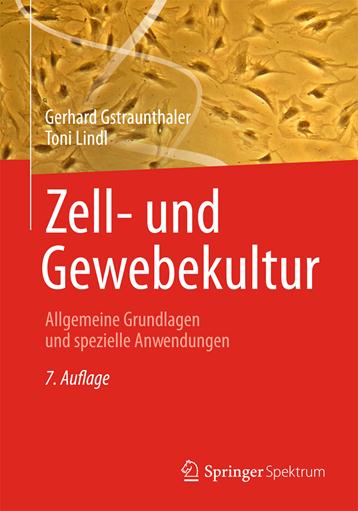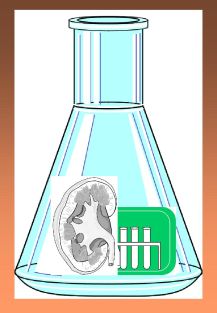Renal Epithelial Cell and Tissue Culture
Group Members: Gerhard Gstraunthaler, Ph.D., Elisabeth Feifel, Ph.D.,
Research Topics
[back to top] [Publications] [Books][News]
Renal Acid-Base Metabolism:
- Biochemical and Molecular Biological Aspects of Renal Ammoniagenesis and Gluconeogenesis,
- pH-Sensing and pH-Signaling in Cultured Renal Proximal Tubular Cells,
- The Role of TGF-b in Renal Acid-Base Adaptation,
- TGFb-Signaling in Proximal Tubular Cells
Growth, Metabolism, and Differentiation of Epithelial Cells in Tissue Culture:
- Optimization of Culture Conditions for Human and Animals Cells,
- Standardization of Cell and Tissue Culture Protocols,
- Alternatives (Replacement) of Animal Serum in Cell Culture Media,
- Quality Control and Quality Management (QC/QM) in Cell and Tissue Culture,
Key Words:
- Acid-Base Homeostasis, Renal Ammoniagenesis, Renal Gluconeogenesis, Ammonia, Glutaminase, PEPCK, pH-Regulated Renal Genes, TGF-b, Cultured Renal Epithelial Cells
General Aspects of Mammalian Cell and Tissue Culture:
- Serum-free Cell and Tissue Culture,
- Alternatives (Replacement) of Animal Serum in Cell Culture Media,
- Quality Control and Quality Management (QC/QM) in Cell and Tissue Culture
Recent publications
[back to top] [pubmed] [Research] [Books] [News]
- Gerhard Gstraunthaler, Caroline Rauch, Elisabeth Feifel and Toni Lindl. Journal of Stem Cells Research, Reviews & Reports. Preparation of Platelet Lysates for Mesenchymal Stem Cell Culture Media.
- Caroline Rauch, Elisabeth Feifel, Angelika Flörl, Kristian Pfaller and Gerhard Gstraunthaler. Human Platelet Lysates Promote the Differentiation Potential of Adipose-Derived Adult Stem Cell Cultures. Journal of Advanced Biotechnology and Bioenineering. 2014 2 (2). P 39-48. dx.doi.org/10.12970/2311-1755.2014.02.02. http://www.synergypublishers.com/downloads/jabbv2n2a1/
- Gstraunthaler, G., Lindl, T., and van der Valk, J., A severe case of fraudulent blending of fetal bovine serum strengthens the case for serum-free cell and tissue culture applications. Altern Lab Anim, 2014. 42(3): p. 207-9. http://www.ncbi.nlm.nih.gov/pubmed/25068932
- Curthoys, N.P. and Gstraunthaler, G., pH-responsive, gluconeogenic renal epithelial LLC-PK1-FBPase+cells: a versatile in vitro model to study renal proximal tubule metabolism and function. Am J Physiol Renal Physiol, 2014. 307(1): p. F1-f11. http://www.ncbi.nlm.nih.gov/pubmed/24808535
- Rauch, C., Wechselberger, J., Feifel, E., and Gstraunthaler, G., Human Platelet Lysates Successfully Replace Fetal Bovine Serum in Adipose-Derived Adult Stem Cell Culture. Journal of Advanced Biotechnology and Bioengineering, 2014. 2(1): p. 1-11. http://www.synergypublishers.com/?did=9610&vp_edd_act=show_download
- Aschauer, L., Gruber, L.N., Pfaller, W., Limonciel, A., Athersuch, T.J., Cavill, R., Khan, A., Gstraunthaler, G., Grillari, J., Grillari, R., Hewitt, P., Leonard, M.O., Wilmes, A., and Jennings, P., Delineation of the key aspects in the regulation of epithelial monolayer formation. Mol Cell Biol, 2013. 33(13): p. 2535-50. http://www.ncbi.nlm.nih.gov/pubmed/23608536
- Gstraunthaler, G., Lindl, T., and van der Valk, J., A plea to reduce or replace fetal bovine serum in cell culture media. Cytotechnology, 2013. http://www.ncbi.nlm.nih.gov/pubmed/23975256
- Kronthaler, J., Gstraunthaler, G., and Heel, C., Optimizing high-throughput metabolomic biomarker screening: a study of quenching solutions to freeze intracellular metabolism in CHO cells. OMICS, 2012. 16(3): p. 90-7. http://www.ncbi.nlm.nih.gov/pubmed/22401654
- Rauch, C., Feifel, E., Amann, E.M., Spotl, H.P., Schennach, H., Pfaller, W., and Gstraunthaler, G., Alternatives to the use of fetal bovine serum: human platelet lysates as a serum substitute in cell culture media. ALTEX, 2011. 28(4): p. 305-16. http://www.ncbi.nlm.nih.gov/pubmed/22130485
- van der Valk, J., Brunner, D., De Smet, K., Fex Svenningsen, A., Honegger, P., Knudsen, L.E., Lindl, T., Noraberg, J., Price, A., Scarino, M.L., and Gstraunthaler, G., Optimization of chemically defined cell culture media--replacing fetal bovine serum in mammalian in vitro methods. Toxicol In Vitro, 2010. 24(4): p. 1053-63. http://www.ncbi.nlm.nih.gov/pubmed/20362047
- Brunner, D., Frank, J., Appl, H., Schoffl, H., Pfaller, W., and Gstraunthaler, G., Serum-free cell culture: the serum-free media interactive online database. ALTEX, 2010. 27(1): p. 53-62. http://www.ncbi.nlm.nih.gov/pubmed/20390239
- Andratsch, M., Feifel, E., Taylor, L., O'Hayre, M., Schramek, H., Curthoys, N.P., and Gstraunthaler, G., TGF-beta signaling and its effect on glutaminase expression in LLC-PK1-FBPase+ cells. Am J Physiol Renal Physiol, 2007. 293(3): p. F846-53. http://www.ncbi.nlm.nih.gov/pubmed/17596530
Books
[back to top] [Research] [Publications] [News]
New Edition / Neuauflage:Textbook on Cell and Tissue Culture (in German):Gerhard Gstraunthaler und Toni Lindl Zell- und Gewebekultur Allgemeine Grundlagen und spezielle Anwendungen 7. Aufl., Springer-Spektrum, Heidelberg ISBN: 978-3-642-33112-1 |
 |
News
[back to top] [Research] [Publications] [Books]
FETAL BOVINE SERUM IN CELL AND TISSUE CULTURE
Fetal bovine serum (FBS) is commonly used as an essential supplement to cell culture media. FBS is a cocktail of most of the factors required for cell attachment, growth, and proliferation in vitro.
DISADVANTAGES IN THE USE OF FBS
However, the use of animal serum also bears a number of disadvantages.
These can either be seen from
(a) a theoretical, cell biological point of view, since serum in general is ill-defined,
(b) from ethical perspectives in terms of animal protection arguments about harvest and collection of FBS from bovine fetuses, and
(c) in terms of recent concerns about the global supply vs. demand of FBS.
It is estimated that about 500.000 litres FBS are produced per year for the world market. This means, that more than 1.000.000 bovine fetuses have to be harvested, and it is expected, that these numbers will continue to increase annually. As a consequence, in terms of the 3Rs, a number of strategies have been developed to reduce or replace the requirement for FBS in cell culture media. As a major goal of these initiatives, any efforts shall be undertaken in order to decrease the global demands for FBS and thus to decrease the number of bovine fetuses needed.
ALTERNATIVES TO FETAL BOVINE SERUM
During the last three decades, FBS could be substituted through other supplements (Rauch et al 2011, 2014) or by the use of defined chemical components in serum-free cell culture (Gstraunthaler, 2003). A number of serum-free media formulations have been described for continuous mammalian and insect cell lines as well as for primary cultures.
Further reading:
- Alternativen zum Fetalen Kälberserum: Neuer Ansatz, neuer Anlauf, neue Hoffnung ?
- A recent misconduct with fetal bovine serum demands to call again for serum-free cell and tissue culture applications
Gerhard Gstraunthaler
Gerhard Gstraunthaler,
Division of Physiology,
Innsbruck Medical University,
Schöpfstraße 41/1,
A-6020 INNSBRUCK, AUSTRIA.
Phone: +43 (512) 9003-70810
FAX: +43 (512) 9003-73800
gerhard.gstraunthaler@i-med.ac.at
Gerhard Gstraunthaler,
Division of Physiology,
Innsbruck Medical University,
Schöpfstraße 41/1,
A-6020 INNSBRUCK, AUSTRIA.
Phone: +43 (512) 9003-70810
FAX: +43 (512) 9003-73800
gerhard.gstraunthaler@i-med.ac.at








